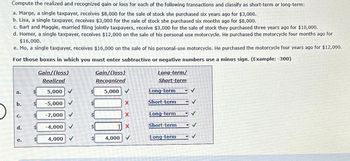
FINANCIAL ACCOUNTING
10th Edition
ISBN: 9781259964947
Author: Libby
Publisher: MCG
expand_more
expand_more
format_list_bulleted
Concept explainers
Question
4

Transcribed Image Text:Compute the realized and recognized gain or loss for each of the following transactions and classify as short-term or long-term:
a. Marge, a single taxpayer, receives $8,000 for the sale of stock she purchased six years ago for $3,000.
b. Lisa, a single taxpayer, receives $3,000 for the sale of stock she purchased six months ago for $8,000.
c. Bart and Maggie, married filing jointly taxpayers, receive $3,000 for the sale of stock they purchased three years ago for $10,000.
d. Homer, a single taxpayer, receives $12,000 on the sale of his personal-use motorcycle. He purchased the motorcycle four months ago for
$16,000.
e. Mo, a single taxpayer, receives $16,000 on the sale of his personal-use motorcycle. He purchased the motorcycle four years ago for $12,000.
For those boxes in which you must enter subtractive or negative numbers use a minus sign. (Example: -300)
P
b.
C₂
d.
e.
$ 5,000
6969
Gain/(loss)
Realized
69
-5,000
-7,000
-4,000
4,000
Gain/(loss)
Recognized
$ 5,000
4,000
X
X
Long-term/
Short-term
Long-term
Short-term
Long-term
Short-term
Long-term
P
Expert Solution
This question has been solved!
Explore an expertly crafted, step-by-step solution for a thorough understanding of key concepts.
Step by stepSolved in 3 steps with 3 images

Knowledge Booster
Learn more about
Need a deep-dive on the concept behind this application? Look no further. Learn more about this topic, accounting and related others by exploring similar questions and additional content below.Similar questions
- A project requires an investment of $900 and has a net present value of $300. If the internal rate of return is 14%, what is the profitability index for the project? Note: Round your answer to 2 decimal places.arrow_forwardwhat are the solutions for questions 4 & 5?arrow_forwardBut why? for number 3arrow_forward
arrow_back_ios
arrow_forward_ios
Recommended textbooks for you

 AccountingAccountingISBN:9781337272094Author:WARREN, Carl S., Reeve, James M., Duchac, Jonathan E.Publisher:Cengage Learning,
AccountingAccountingISBN:9781337272094Author:WARREN, Carl S., Reeve, James M., Duchac, Jonathan E.Publisher:Cengage Learning, Accounting Information SystemsAccountingISBN:9781337619202Author:Hall, James A.Publisher:Cengage Learning,
Accounting Information SystemsAccountingISBN:9781337619202Author:Hall, James A.Publisher:Cengage Learning, Horngren's Cost Accounting: A Managerial Emphasis...AccountingISBN:9780134475585Author:Srikant M. Datar, Madhav V. RajanPublisher:PEARSON
Horngren's Cost Accounting: A Managerial Emphasis...AccountingISBN:9780134475585Author:Srikant M. Datar, Madhav V. RajanPublisher:PEARSON Intermediate AccountingAccountingISBN:9781259722660Author:J. David Spiceland, Mark W. Nelson, Wayne M ThomasPublisher:McGraw-Hill Education
Intermediate AccountingAccountingISBN:9781259722660Author:J. David Spiceland, Mark W. Nelson, Wayne M ThomasPublisher:McGraw-Hill Education Financial and Managerial AccountingAccountingISBN:9781259726705Author:John J Wild, Ken W. Shaw, Barbara Chiappetta Fundamental Accounting PrinciplesPublisher:McGraw-Hill Education
Financial and Managerial AccountingAccountingISBN:9781259726705Author:John J Wild, Ken W. Shaw, Barbara Chiappetta Fundamental Accounting PrinciplesPublisher:McGraw-Hill Education


Accounting
Accounting
ISBN:9781337272094
Author:WARREN, Carl S., Reeve, James M., Duchac, Jonathan E.
Publisher:Cengage Learning,

Accounting Information Systems
Accounting
ISBN:9781337619202
Author:Hall, James A.
Publisher:Cengage Learning,

Horngren's Cost Accounting: A Managerial Emphasis...
Accounting
ISBN:9780134475585
Author:Srikant M. Datar, Madhav V. Rajan
Publisher:PEARSON

Intermediate Accounting
Accounting
ISBN:9781259722660
Author:J. David Spiceland, Mark W. Nelson, Wayne M Thomas
Publisher:McGraw-Hill Education

Financial and Managerial Accounting
Accounting
ISBN:9781259726705
Author:John J Wild, Ken W. Shaw, Barbara Chiappetta Fundamental Accounting Principles
Publisher:McGraw-Hill Education